By Andy May
The only recent attempt at a global Holocene temperature reconstruction available today is the one by Marcott, et al. (2013), the paper abstract can be viewed here. His reconstruction is shown in figure 1.
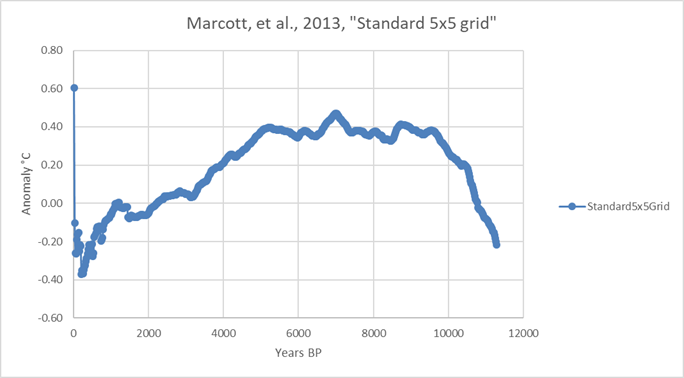
Figure 1
The Y axis is a reconstructed global temperature anomaly from the 1961-1990 mean. “Years BP” are years before 1950. This reconstruction shows a fairly flat Holocene Climatic Optimum (or HCO, also called the Holocene Thermal Optimum, see description here) temperature anomaly of +0.4°C from 9500 BP to 5000 BP, declining to a low of -0.4°C about 300 BP (1650 AD) in the Little Ice Age (LIA). This 0.8°C difference between the HCO and the LIA is smaller than the generally accepted difference of 1°C to 1.5°C. This is documented in some detail by Javier here. The higher accepted difference is clear in glacial records as shown by Koch, et al., 2014 (link). It can also be seen in the biosphere as shown by Kullman 2001 (link); Pisaric et al. 2003 (link); MacDonald et al. 2000 (link); Tinner, et al. 1996 (link) and Thouret et al. 1996 (link)). Further, the marine biosphere also shows a larger temperature difference as seen in Werne et al., 2000 (link) and Rosenthal et al., 2013 (link).
The reconstruction in figure 1 goes from the present (1950) on the left to nearly the beginning of the Holocene about 11,700 years ago on the right. The Holocene is normally defined as “the first signs of climatic warming at the end of the Younger Dryas/Greenland Stadial 1 cold phase” (Walker et al. 2009). It is often considered a geological epoch or series. It is part of the Quaternary geological period and is equivalent to the older geological term “Recent.”
The reconstruction shows an abrupt warming in the last 100 years (see the left side of figure 1). This single point at 1940 AD is due to proxy drop out, proxy inconsistencies and the authors changing some published dates in the proxies according to Steve McIntyre at climateaudit.org here, here and here. Also see “The Tick” by Grant Foster here for more discussion, the first comment to “The Tick” is by our own Nick Stokes. Even Marcott has acknowledged that his reconstruction from 1890 AD onward is not robust. The following quote is by Marcott, here.
“We showed that no temperature variability is preserved in our reconstruction at cycles shorter than 300 years, 50% is preserved at 1000-year time scales, and nearly all is preserved at 2000-year periods and longer. Our Monte-Carlo analysis accounts for these sources of uncertainty to yield a robust (albeit smoothed) global record. Any small “upticks” or “downticks” in temperature that last less than several hundred years in our compilation of paleoclimate data are probably not robust, as stated in the paper.”
The problem is that 300 years is a very long time. As we will see, many very significant climatic events begin and end in less than 300 years. Marcott et al. (2013) chose too many proxies with poor temporal resolution, which reduced the resolution of their reconstruction to the point that significant details were lost.
This is a new look at Marcott’s proxies. It is a good collection and most of them are marine sea surface temperature proxies. This is a good thing because most of the heat energy or heat capacity on the Earth’s surface is in the oceans. In fact, over 99.9% of the surface heat content is in the oceans and only 0.071% is in the atmosphere, for the details of this calculation see the spreadsheet here. Warming of the atmosphere is not particularly significant on a climatic scale.
It is very logical to investigate long term climate changes using ocean temperature proxies from foraminifera shells and fossils (“forams”), planktonic and algal material. Traditionally the magnesium and calcite (Mg/Ca) percentages or d18O ratios in planktonic foraminifera have been used to deduce ancient sea surface temperatures. On land, ice core d18O records and pollen are used to estimate ancient air temperatures. More recently we have seen more use of haptophyte algal alkenones, especially the U37K’ (also written as UK’37) index to get ancient sea surface temperatures, see the link here. TEX86 records from marine plankton have also been used recently to obtain sea surface temperatures and are among Marcott’s proxies, see here for a discussion. The original reference for the TEX86 sea surface temperature proxy is Schouten, et al. (2002) here. A complete list of the proxies used by Marcott, plus one I added from Rosenthal, et al. (2013) and references and links to the original papers can be downloaded here. I did not use all Marcott’s proxies in my reconstructions, those that I did use are noted in the spreadsheet.
Proxy selection
The proxies were examined considering the criticism of Marcott’s analysis by Javier, McIntyre and Foster. The 500-meter depth Indonesian ocean proxy presented in Rosenthal, et al. 2013 was added to the list. Proxies used in this reconstruction were selected using the following criteria:
- The span of the proxy reconstruction had to cover at least 600 BP to 8000 BP so the proxy covered part of the LIA and the HCO.
- The resolution (time between samples) had to be less than 130 years.
- Complex statistical techniques were avoided as much as possible.
The major climatic events of the Holocene are the Holocene Climatic Optimum (HCO) and the Little Ice Age (LIA), these events represent the maximum global average temperature and the minimum temperature respectively in this period. As noted above, there is abundant evidence that the global temperature difference between these two points exceeds one degree Celsius. Therefore, it seems logical to make sure the proxies cover both events. Further, since all the reconstructions are temperature anomalies, we have built the anomalies as differences from the proxy mean between 9000 BP and 500 BP.
There is concern that the reason the Marcott, et al. (2013) reconstruction is underestimating the LIA to HCO temperature difference is that they included too many proxies with very long sample intervals. Proxies with long sample intervals miss essential detail and smooth and dampen detail in any reconstruction. Just averaging too many proxies can dampened detail if there is error in the proxy dates.
Climate changes over the Holocene occur, in large part, by latitude. This is due to the Earth’s orbital obliquity (amount of axial tilt which changes over a 41,000-year cycle) and precession (wobbling of the axis over 19,000 to 23,000 years) cycles, as well as the long-term transport of heat by ocean currents. This is explained well by Javier here. In the same post, Javier explains the orbital effects in this way:
“Changes due to obliquity have the effect of redistributing insolation between different latitudes following an obliquity cycle of 41,000 years. When obliquity was maximal 9,500 years ago, both poles received more insolation due to obliquity, while the tropics received less. Obliquity also affects seasonality, at maximal axial tilt, there is an increased difference between summer and winter at high latitudes. But unlike precession changes, obliquity alters the amount of annual insolation at different latitudes in a 41,000-year cycle. This is represented by the background color of figure 34, that shows how the polar regions received increasing insolation from 30,000 yr BP to 9,500 yr BP. Since then, and for the next 11,500 years, the poles will be receiving decreasing insolation. Unlike precessional insolation changes, obliquity changes are symmetrical. Although the annual insolation change is not too large, it accumulates over tens of thousands of years and the total change is staggering, creating a huge insolation deficit or surplus. This changes the equator-to-pole temperature gradient, and is largely responsible for entering and exiting glacial periods (Tzedakis et al., 2017) and for the general evolution of global temperatures and climate during the Holocene.”
The emphasis is in the original post. Javier’s figure 34 is presented below as our figure 2.
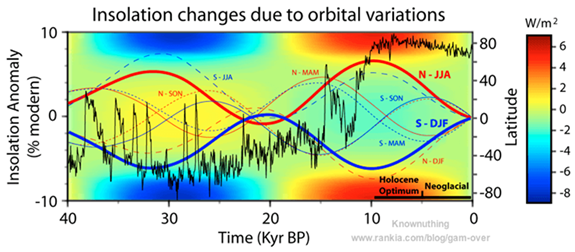
Figure 2
Javier’s description of this figure, in part:
“Figure 34 [our figure 2]. Insolation changes due to orbital variations of the Earth. The insolation changes for the last 40,000 years are represented. Black temperature proxy curve represents d18O isotope changes from NGRIP Greenland ice core (without scale). The insolation curves are presented as the insolation anomaly for summer, winter, spring, and fall. N (red) or S (blue) are the Northern or Southern Hemisphere and the three letters are the month initials. Northern and southern summer insolation represented with thick curves. Background color represents changes in annual insolation by latitude and time due to changes in the Earth’s axial tilt (obliquity), shown in a colored scale. … changes in obliquity … are symmetrical for both poles. Changes … caused by the precession cycle (modified by eccentricity) are asymmetric and less important for the global response, although they cause profound changes in regional climatic differences. The Holocene Climatic Optimum corresponds to high insolation surplus in polar latitudes (red area), while Neoglacial conditions represent the first 5,000 years of a 10,000 year drop into a high glacial insolation deficit in polar latitudes (blue area).”
Since latitude has such a large influence on climate and climate changes, we will produce reconstructions in 30° regions of latitude. The Antarctic region, with latitudes from 90°S to 60°S is presented first in this post. In the next post, we will present reconstructions for the southern hemisphere mid-latitudes (60°S to 30°S) and for the tropics (30°S to 30°N). The northern hemisphere mid-latitudes and the Arctic will follow in part 3. Our final global reconstruction will be a combination of these. It is presented in part 4.
The Marcott, et al. (2013) reconstruction is based upon 5° by 5° global grid created using their proxies. Gridding data is an accepted way of spreading unevenly spaced data evenly over a map, but it can cause distortions. The distortions can occur due to isolated, but extreme values or because the values gridded are incompatible, or simply because of data clustering, that is many values in one part of the map, see an example here. Table 1 shows the distribution of the proxies used in this series.
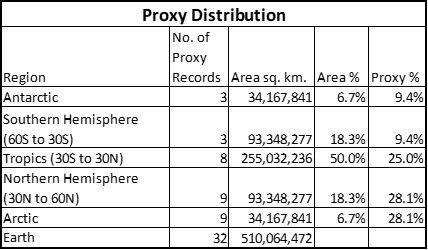
Table 1
The Marcott, et al. (2013) proxies are much more numerous in the northern hemisphere than in the south, so for this reason, we chose not to grid the data, but instead create five simple latitude bounded regional reconstructions and merge them. A great effort was made to make the process used as simple as possible and completely reproducible. All calculations were done with R, a statistical software package that is available for free (see here). As you can see in table 1, only 19% of the proxies that meet our criteria fall in the southern hemisphere below 30°S, which is 25% of the Earth. The same 25% area in the northern hemisphere contains 56% of the proxies. We hope that using our method will reduce any distortion introduced by the proxy distribution.
All R code and the R input and output text files will be made available in the supplementary materials for each post. We also provide spreadsheets containing metadata, references and plots of the original proxy temperatures. No error analysis has been done on these reconstructions, but this should be done. Readers are encouraged to use my code and data to do their own error analysis. Ideas on how to separate the various error components, such as dating error, proxy error, geographic error, depth or altitude error, etc. are welcomed. One thing that complicates the computation of error, is that in some cases different proxies were used for the same core (see 74KL, in the Arabian Sea, by Huguet et al., 2006) and the resulting reconstructions were different. This could be due to seasonal differences, depth or altitude differences or due to local weather variability (Huguet, et al. 2006). In all cases I used the original published dates, no adjustments have been made except to align them to a 1950 reference which is the standard reference for “BP.”
The Antarctic reconstruction
The final Antarctic reconstruction is shown in figure 3. The curve is the anomaly from the 9000BP to 500 BP mean.
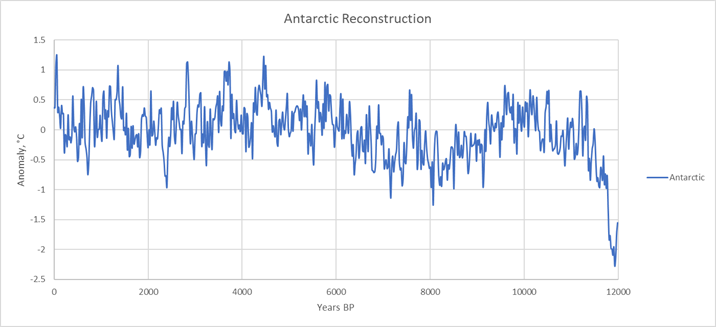
Figure 3
In the Antarctic reconstruction, we appear to see a slight Little Ice Age drop at 1230 AD. There are several peaks in the Medieval Warm Period from 1110 AD to 890 AD, but nothing very dramatic.
Marcott, et al. (2013) had four temperature proxies below 60°S. We selected three from this set, Vostok, Dome C and EDML. The proxy details and metadata are in the supplementary spreadsheet “Reconstruction_References.xlsx” which can be downloaded here. Dome F was rejected due to a 500-year resolution. These are all ice core proxies that estimate air temperature. A map of the proxies (see figure 4) shows that all are in East Antarctica.
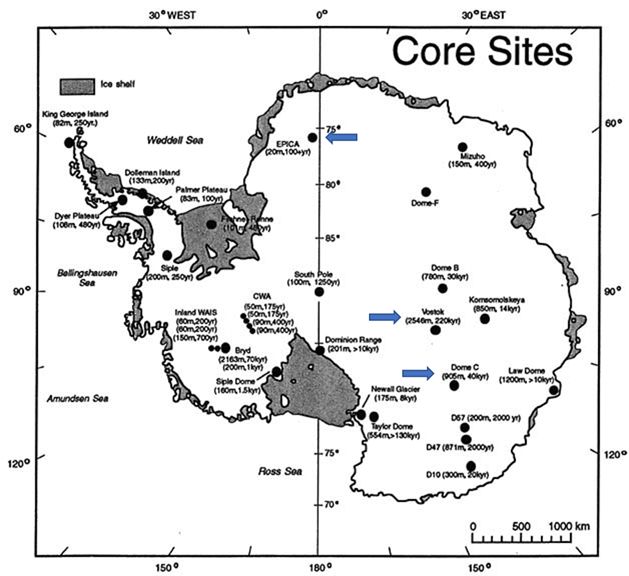
Figure 4
Figure 5 shows the three proxies used in the reconstruction. All of the proxies are anomalies from the 500BP to 9000 BP mean.
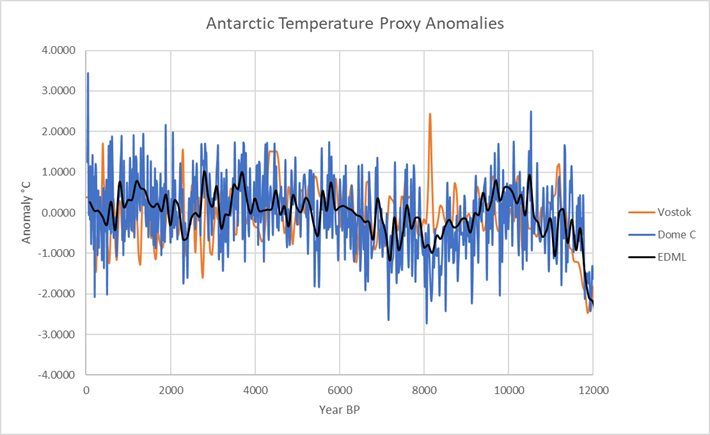
Figure 5
The three proxies generally agree with one another and the reconstruction, with minor suspicious looking differences such as the spike in the Vostok record at 8200 BP.
After reading the proxies into R, a matrix of reconstructed temperatures was created with a regular spacing of 20 years from -60 BP (2010) to 11980 BP (10,030 BC). This matrix is then populated with the proxies, taking care to average multiple values if they are within 11 years of the matrix date. Gaps in each proxy are filled with a cubic spline function allowing a maximum gap of 11 samples or 220 years. No extrapolation at the ends of the vectors was allowed, this is to reduce the chance of spurious spikes at the end of the proxy records.
After filling gaps table 2 shows the beginning of the matrix:
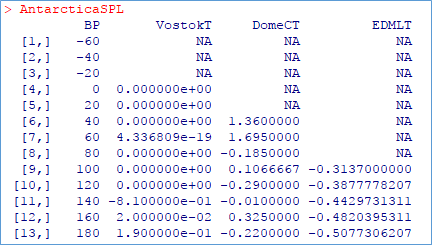
Table 2
Most of Marcott’s proxies contain actual estimated temperatures, but these proxies are all anomalies. The R missing value code is “NA.” The anomalies are from different means. The zeros from 0 BP to 120 BP in the Vostok column look suspicious, but they are in the Pettit, et al. (1997) data. By 100 BP (1850 AD) we have data for all three cores. Dome C shows warming from 100 BP to 40 BP, so the uptick at the end of the reconstruction is due to two points in one core. Table 3 shows the end of the matrix.
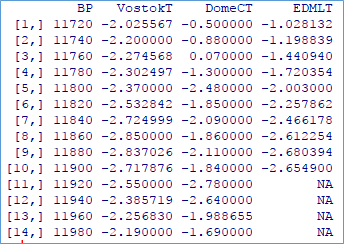
Table 3
All three cores show rapid warming from 11900 BP to 11720 BP. Each of the three proxies are converted to new anomalies from their individual mean temperatures from 9000BP to 500 BP, this is to give them all the same chronological basis. Finally, the Antarctic region reconstruction is created by averaging the three anomalies. The result is figure 3. Figure 6 is the same reconstruction, but plotted by R with an overlain smoothed curve.
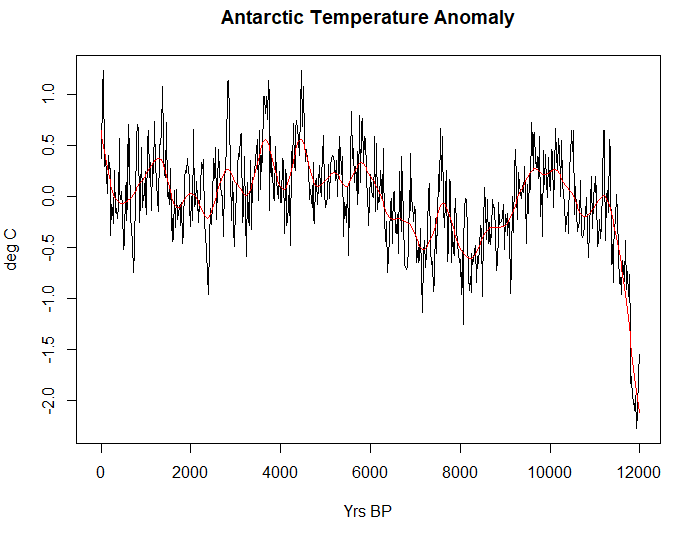
Figure 6
The graph shows Holocene climatic optima from 11000 BP to 9500 BP and 6000 BP to 3000 BP. The later period is slightly warmer than the earlier period which is very different from what is seen in the northern hemisphere and the other regions in this study. This result is similar to what has been reported by Masson, et al., 2000. Masson, et al. (2000) write:
“All the records confirm the widespread Antarctic early Holocene optimum between 11,500 and 9000 yr; in the Ross Sea sector, a secondary optimum is identified between 7000 and 5000 yr, whereas all eastern Antarctic sites show a late optimum between 6000 and 3000 yr.”
Unlike Masson, et al. (2000) we show the later optimum to be slightly warmer than the earlier one. But, the difference is only a few tenths of a degree and probably not significant. The choice of proxies can be critical when dealing with small differences in temperature. It is interesting to look at the variety of deuterium profiles presented by Masson, et al. (2000) in their figure 3, which is not reproduced here.
Likewise, the rapid warming out of the Younger Dryas seen in the northern hemisphere around 11500 BP appears to occur hundreds of years earlier in the Antarctic. It is also possible that there is no discernable Younger Dryas cooling in the southern hemisphere (Barrows, et al., 2007). Southern Ocean sea surface temperature reconstructions shown in Bostock, et al. (2013) (see their figure 3B, reproduced as our figure 7) show that the early temperature optimum in the Southern Ocean is quite variable. In some areas, it is at about 10000 BP and in others it is about 6000 BP. But, often the difference between the peaks is quite small and perhaps below the accuracy of the data.

Figure 7 (source Bostock et al., 2013)
Our proxies are all eastern Antarctic land air temperature proxies and they reach a much later peak, around 6000 BP to 3000 BP by a few tenths of a degree.
Conclusions
The Marcott, et al. 2013 worldwide reconstruction has its problems, but many of the proxies used in the reconstruction are quite good and very usable.
The Antarctic reconstruction created here is comparable to previous temperature reconstructions, especially those focusing on eastern Antarctica. It shows two climatic optima, one from 11500 BP to 9000 BP and another from 6000 BP to 3000 BP. In eastern Antarctica, using our proxies, the later optimum is warmer. But, in other areas the earlier optimum is warmer, however, the difference is small.
In following posts, I will create similar reconstructions for the Arctic, the southern and northern mid-latitudes and one for the tropics. These will be area weighted and merged into one proposed global reconstruction in the final post.
The R code used to create this reconstruction and the input and output datasets can be downloaded here. The list of proxies used for all six reconstructions, the original references and links can be downloaded here.
I am very grateful to Javier who has read this post and made many very helpful suggestions. Any errors are the author’s alone.
There has always been something that has interested me and that has been the speed at which the glacial periods end. Orbital changes happen gradually with insolation slowly increasing but we see the coldest temperatures of the entire glacial immediately before it suddenly jumps to modern temperatures. While this might be the sudden kicking in of ocean circulation that had been impeded, I don’t know.
One thing I would be interested in discovering is if sea level rise leads or lags the sudden rise in temperatures as we come out of the LGM. The shallowing of the region between Florida and Cuba would likely produce quite a restriction on flows around the tip of Florida and up the US east coast. So the more continental ice we get, the shallower this area gets, the less water flows that direction, and it tends to reinforce the cooling at northern latitudes. If the sea level rise leads the increase in temperatures, maybe we get to a point where the sea levels rise enough for enough water to flow around the end of Flordia for the circulation to kick in again to bring warm water farther north.
Crosspatch – sea-level rises 200m and the lapse rate is ~1C per 100m so a 2C rise in temps as a result seem to me to be basic physics – assuming your proxy measures temps in the same location. You essentially lowered the land by 200m so it got hotter. I’ve not heard this discussed much though.
Good work. Thanks!
The 8.2 Ka cooling event shows up, interrupting the HCO, but not the YD. Interesting.
They both probably had the same cause, ie sudden cold fresh water entering the oceans from ice-dammed deglaciation melt.
The YD was primarily a northern hemisphere phenomenon. At that time the bipolar seesaw was in operation, the NH warming of the Bolling-Allerod was accompanied by the Antarctic cold reversal. Then at the YD Antarctic warming resumed.
http://home.sandiego.edu/~sgray/MARS350/deglaciation.pdf
What is interesting is the possible effect of estimated 300 year “averaging” of temperature, as the Little Ice Age is estimated to be less than twice that period.
And in the Antarctic reconstruction, the Greek Dark Ages Cool Period was colder than either the Dark Ages CP or the LIA. But the peaks are there after the last blast of the HCO, c. 5 Ka, ie the Egyptian, Minoan, Roman, Medieval and Current Warm Periods, at roughly regular 1000-year intervals.
That these cycles were global is in doubt only in CACAland. That their relative depths and heights might differ slightly on the coldest continent isn’t surprising.
Tom Halla-
You bring up a critical point. The smoothing effect is such that less than 10% of temperature variation remains at a period of 300 years, and only 50% of temperature variation is retained at a 1000 year period.
I modeled the low pass filter and calculated the expected output for various input temperature variations.
For example, a +85 C temperature increase for 1 year would show up as a 0.09 C blip, and would be difficult to identify in the Marcott reconstruction.
There were some spurious characters in the post, I think I cleaned them up, but let me know if I missed any. They were around the degree symbol and the Greek letters.
I have read at WUWT and elsewhere that climate models predict more warming at the poles than elsewhere. Instrumental Arctic data show notable increases in recent decades but similar records for the Antarctic, such as presented at climate4you.com, do not. Is the predicted increase in Antarctic temperature so tiny that it should not be seen, or so large that it should have been by now?
I’m not too sure about polar amplification, all of the regions have a similar anomaly profile but one, wait and see part 3.
Waiting. Meanwhile, check climate4you polar temperature page, though I suspect you have the data. I would post some of the charts here if I knew how. I cannot see any trend in recent decades for Antarctic temps but for the peninsula. Even HADCRUT is flat to my eyes. What am I missing? I’ll wait.
Are these some of what you wanted to post, DHR?
Antarctic long meteorological data series
http://climate4you.com/images/AntarcticTemperatures.gif
Arctic long meteorological data series
http://climate4you.com/images/ArcticTemperatures.gif
(Source:
Dr. Ole Humlum
http://www.mn.uio.no/geo/personer/vit/geohyd/olehum/olehum.jpg
(the face of a true hero for science truth)
(http://www.mn.uio.no/geo/personer/vit/geohyd/olehum/index.html)
at: http://climate4you.com/ )
DHR, FYI (while I wait for my 4:45pm comment to you with the charts you wanted to post (I hope) to appear — 5 links was too much for poor widdo WordPress to handle, sigh):
How to copy an image into a comment.
1. Right click on image.
2. Left click on “copy image” (in little pop-up menu box)
3. In WUWT comment box, type Ctrl-v (or V) — simultaneously.
Voila!
I highly recommend using the Test page to try out every image. Usually, if their link ends in “.jpg” or “.gif” or “.png” they work, but, not always.
Find a photo online and try posting it here (after testing) to show me you understood my amateur instructions, okay?
You can use duckduckgo.com or Bing (or the other one — actually, unfortunately, this one G__ works consistently best for image searches) to search for images — just click on “image” in the menu bar across the top of the page to load images, instead of just “news” or “all.”
DHR — I MESSED UP! So sorry.
Correction:
2. Left click on copy image address.
I use “copy image” to paste images into e mails. It doesn’t (as far as I know) work here.
Statistics is no substitute for physics. None of those temperatures involve a physical transformation of proxy metric to Celsius. They’re all purely statistical manipulations and physically meaningless.
And the plots have no uncertainty bars, and they suppose an impossible accuracy of 0.2 to 0.5 C.
Regrets, guys, I know you all worked hard, but much better to put your effort into meaningful work.
Suggestions on how to compute the uncertainty bars? And please, do not suggest Monte Carlo.
Andy, there can be no physically valid uncertainty bars on a purely statistical manipulation of proxies. The statistical “temperatures” are not physical temperatures. They haven’t any physical meaning.
I’ve published two papers deriving a lower limit of uncertainty on the surface air temperature record here (1 mb pdf) and here. These are based on systematic sensor measurement error; error thoroughly neglected in the field.
I also have a post on WUWT describing the systematic error in the air temperature record, here.
And I hope this comment survives, what with three links and all. 🙂
Pat, thanks for the links. I don’t disagree with most of what you’ve written, perhaps none of it. Especially regarding air temperatures. But, air temperatures are not very important climatically, they represent such a tiny percentage of the heat on the Earth, as explained in the post and have low thermal inertia. I’ve deliberately tried to use as many marine SST proxies as possible in this reconstruction for that reason, see the next three parts for details. So far as I can tell right now, I do not think an accurate temperature reconstruction of global average temperature is possible prior to 1979 when satellite data became available – and some would argue that isn’t accurate! I’ve looked at lots of proxies and despair that I can challenge each and every one. I also cannot figure out how to estimate their error in a reasonable way, without simply using standard deviation, or some related statistic. So I didn’t bother. This idea is to try to reach an agreed estimate using the best proxies and the simplest methods. Not ideal. But, having an agreed reconstruction, that fits all known data, may be the best we can do. Lots of the best data are historical, archeological, biological (reefs mainly) and geological. We can use this sort of data to guide proxy selection and calibration. Best we can do as far as I know, right now. We can’t go back in time and shoot up satellites.
I very much appreciate the open-mindedness of your reply, Andy. You’re a rare guy. 🙂
The central point about proxies is that there’s no way to turn them into temperatures. They can show warmer/cooler — wetter/drier. But they cannot show degrees centigrade (Celsius). Even dO-18 proxies can’t be turned into temperature because of the confounding effect of shifting monsoon tracks and rain-out.
Consensus proxy paleo-temperature reconstruction is, in a word, pseudo-science. Pure and simple.
It’s best to just leave the whole proxy business alone unless, like Paul Dennis, you’re actually working on a way to derive a proxy that can be converted to physically real temperatures. That’s science. The rest of it is not. In spades.
Paul is doing the hard gritty work of science, paying attention to detail, laboring in relative obscurity. He’s an honest scientist.
Mann, Thompson, and the rest are garbage-producing grand-standers, who’ve garnered large rewards for it. The whole business is despicable.
Well, that’s not the issue, Pat.
The important think for a climate proxy is that it is internally consistent, i.e. that changes in the proxy actually represent real changes in climate. Whether it can be translated to °K or not is very secondary. While we still ignore most about climate of the past, we have learned a great deal in the past few decades.
Science is paying attention to details, Javier, not hand-waving them away.
Putting temperature degrees onto proxy graphs is fakery. But for you, apparently, fakery is a secondary issue.
Stenni et al., 2017
http://www.clim-past-discuss.net/cp-2017-40/cp-2017-40.pdf
“Within this long-term cooling trend from 0-1900 CE we find that the warmest period occurs between 300 and 1000 CE, and the coldest interval from 1200 to 1900 CE.”
“Our new continental scale reconstructions, based on the extended database, corroborates previously published findings for Antarctica from the PAGES2k Consortium (2013): (1) Temperatures over the Antarctic continent show an overall cooling trend during the period from 0 to 1900 CE, which appears strongest in West Antarctica, and (2) no continent-scale warming of Antarctic temperature is evident in the last century.”
“A recent effort to characterize Antarctic and sub-Antarctic climate variability during the last 200 years also concluded that most of the trends observed since satellite climate monitoring began in 1979 CE cannot yet be distinguished from natural (unforced) climate variability (Jones et al., 2016), and are of the opposite sign [cooling] to those produced by most forced climate model simulations over the same post-1979 CE interval.”
http://notrickszone.com/wp-content/uploads/2017/03/Holocene-Cooling-Antarctic-Stenni-17-East-West-Whole-Antarctica.jpg
Yep, agreed. Compare mine with Stenni, et al.’s East Antarctica plot.
http://notrickszone.com/wp-content/uploads/2017/03/Antarctica-UAH-1979-2016.jpg
Ken,
The El Ninos and La Ninas really show up there, don’t they?
So much for polar amplification.
The North and South poles are completely different animals.
Andy May, are you the same Andy May who made this comment at notrickszone: http://notrickszone.com/2017/06/01/3-chemists-conclude-co2-greenhouse-effect-is-unreal-violates-laws-of-physics-thermodynamics/#comment-1212253 ?
Yep.
You’re in danger of being cast into outer darkness as a banned Sl@yer. Recant, heretic!
Just kidding.
My own view is that there is a GHE, but that in the atmosphere of a self-regulating planet, feedbacks are net negative, such that ECS (if it exist) should be between 0.0 and 1.0 degrees C per doubling of CO2. Can’t rule out an actual cooling effect, however, particularly in the hot (above 30 degrees C), moist tropics, for an ECS of -0.5 to 0.0 degree C per doubling.
Unlike some, I do not want to reject the views of so many very qualified theoretical physicists (Claes Johnson, Ferenc Miskolczi, Gerlich, Tscheuschner, Kramm and Dlugi) being somewhat inclined toward physics myself. I’m not saying I buy into all of it, I just cannot reject it. The meaning of the comment however was simple. CO2 has little effect in the lower atmosphere because the heat of the lower atmosphere and surface (especially the ocean surface) is transported mostly by water and water vapor or melting ice. CO2 plays a large role in radiating heat energy to outer space though from the upper atmosphere, especially in the stratosphere. It acts primarily to cool the Earth. Does a change in CO2 concentration somehow slow the transport of heat energy to outer space?? I’ve seen no evidence that this is the case, but I’m all ears.
Warmunistas themselves say that CO2 cools the stratosphere and point to its cooling as a sign of AGW via GHGs.
Gabro, an all-in ECS to CO2 between 0 and 1 is reasonable. I agree most feedbacks are probably negative given what I’ve read and the direct CO2 effect is less than 1 per doubling. But, there is so much we don’t know. The CO2 effect is so small in the lower atmosphere relative to water vapor we may never even detect it. In the stratosphere or at the poles maybe we can see an effect at some point, but we aren’t looking very hard there.
Andy,
I agree that the dry polar deserts are the places to look for any measurable GHE of CO2, where its low concentration is similar to H2O, unlike most of the rest of the world, where water vapor is up to two orders of magnitude greater than CO2, the absorption bands of which overlap greatly.
okay Andy. Now I can classify your post and decide if I read it or not. I tend to not.
Your choice.
Well, we can tell by direct observation that today is cooler than it was years ago. They were grazing cattle in Greenland on farms that are still frozen in permafrost today. There were working copper mines in the alps that are still glaciated today. There were valleys in Scandinavia that were being farmed that are too cool to produce a crop today.
crosspatch
June 1, 2017 at 11:21 am
I’ve heard this report of the glaciated alpine Cu mines before…do you happen to have have a link to the background on this? Thanks.
FANTASTIC ARTICLE, Andy May! (Pat Frank’s excellent, expert-knowledge, points notwithstanding — i.e., the issues you’ve raised and the education you’ve provided, even though no physical meaning to degrees (warmer/cooler IS still valid), are terrific.) Thank you.
************************************
I hope this is helpful, Mr. Brickell:
(Source: Glacial Fluctuations and Exploitation of Copper Resources in High Mountain During the Late Neolithic and Bronze Age in the French Alps (2500-1500 BC), https://www.researchgate.net/publication/216250097_Glacial_Fluctuations_and_Exploitation_of_Copper_Resources )
p. 81
p. 84
p. 87
p, 89
Translation from original language errors corrected at times using { } to indicate deleted characters. My question in { } about “thin correlation” is the only annotation.
*********************************************
btw: I hope someone can answer my question, i.e., “How should I reconcile closely related to glacial abandonment with thin correlation between climate changes?
Thanks Janice, this is a valuable reference!
Very interesting work. I look forward to the sequels.
well i definitely agree that a 300 yr resolution of the plot rules out shifts and decreases the HCO and LIA, however even with this resolution a change of 0.8°C is very significant
i agree that shorter cycles and swings are ruled out but it gives a very different perspective on the matter: how on longer terms the climate did change.
it places the actual bit of warming into a correct perspective: in a 300 yr plot we would not even see it.
While Marcott’s graph (Figure 1) seems to replicate Mann’s ‘Hockey Stick’, I didn’t know that it ended in 1950. Knowing that, it looks like this “unprecedented warming”, if real, likely isn’t related to CO2.
Also, Marcott (possible by accident) told us that the large uptick likely is not unusual. If nothing shorter than 300 years could be detected in his proxies, the current warming would be lost in the noise. It was truly disingenuous of him to even show it. Seems he was replaying Mann’s ‘Nature Trick’.
Perhaps so, I’m not sure. He was quite clear about his resolution problem, but did not directly address the uptick as he should have.
Marcott et al., themselves deprecated their own figure when questioned about the statistical reliability of the terminal spike. Their exact words were:
So given the widespread distribution of the graph and the “false conclusion” in the media at the time of publication, the only possible conclusion is that it was a publicity stunt based on weak science.
Hmm. While not disputing the uptick in recent warming, I do also see what appears to be a sudden increase in ‘precision’ as you get close to modern day proxy’s for the temperature. That’s part of what is so frustrating with the whole ‘debate’ is that temperature changes and decadal variations get smoothed (crushed/melted etc) out over 1000s of years…
How very true! I don’t know what to do about it though, other than to be aware of it.
I don’t think -40C +/- 0.4C is very meaningful. Let’s face it, Antartica has remained dash cold all this time.
True and you will see as we go through the regional reconstructions that only one has any significant variability after the end of the Younger Dryas. The others stay within +-1 degree. Marcott, et al.’s +-0.4 is dampened due to the proxies they used. Mine is dampened by the proxies I chose and the sampling of the proxies, just not as much.
It’s always amused me how many warmunists are terrified of the Antarctica glaciers melting because of a 2 to 3C increase in temperatures. They don’t understand how cold it is down there and apparently don’t want to.
That’s the definition of the Quaternary Ice Age. By reading newspaper headlines one would think it just ended.
😉
And Antarctic ice sheets built up quickly under CO2 levels of at least 700 ppm and possibly more than 2000 ppm.
CO2 concentration at the Eocene-Oligocene boundary is not well constrained.
Great work Andy. I like your zonal approach and look forward to the remaining installments. I too have looked at proxy data for paleo temperatures, as summarized here:
https://oz4caster.wordpress.com/paleo-climate/
Here is my simplistic integration of two Antarctic and two Greenland ice core proxies for the Holocene here:
https://oz4caster.wordpress.com/2014/12/29/holocene-climate/
From what I have seen, one of the major difficulties in working with proxy data for temperatures is the calibration of the temperature to the proxy and understanding how large of a geographic area is represented. Another major difficulty is determining the representative time of each sample. Despite these difficulties, which appear to introduce a large amount of uncertainty both in temperature estimates and time estimates, these proxies are the most complete evidence we have for paleo climate and often seem to corroborate well with fossil and geological evidence.
Thanks Bryan. I appreciate your posts. I agree with you, we have little to work with, but it is all we have. I’ve given up on reconstructions several times, but I always go back and work on them again. We have to understand the climate of the past to get perspective on the present. I still think we can get somewhere if we try and integrate all data.
Please correct:
climateaudit.org not climateaudit.com
fixed.
Well done & comprehensive. Your continuing work should be very interesting.
Andy,
the Marcott paper states
“”“We showed that no temperature variability is preserved in our reconstruction at cycles shorter than 300 years, 50% is preserved at 1000-year time scales, and NEARLY all is preserved at 2000-year periods and longer.”””
This is the admittance that his paper is of LOW, if of any, quality. A lot happens in global climate within 300 years and that 50% info is lost on a 1000 yr scale…terrible……
It makes no sense to use this kind of study AT ALL.
The GISP2 (Alley) values for example, clearly show steady warming peaks every 62 years, thus showing ACCURACY.
Andy, check the Marcott values on the 62 yr cycle, and if it doesnt show then trash
the Marcott et al. The 62 yr cycle check should be obligatory for each proposed time series.
JS.
The most interesting chart of Antarctic temperature is the decadal shift in winter but absolutely ni change in summers. See here. . Now CO2 cannot be the cause, so what is? Ozone maybe? But where does it get its hest from in winter…..surely not IR ftom earths surface..coukd it?
. Now CO2 cannot be the cause, so what is? Ozone maybe? But where does it get its hest from in winter…..surely not IR ftom earths surface..coukd it?
Oops. Fat fingers. ozone Heat in winter ( not hest).
This is very important work. At a time when climate science is subject to a profound debate that is affecting what we know about past climate changes, it is very important to review what the evidence supports and what it doesn’t. Our knowledge of the Holocene climate is rapidly evolving, and we know a lot more than we did just 20 years ago, but still what we don’t know is a lot more than what we know.
It is not so important to know exactly the temperature changes that have taken place. Climate change is a lot more than temperatures, and a global average has little meaning. Still, it is a good way of knowing the evolution of our interglacial, and in the regional way that Andy is showing it leads to a much better understanding of the changes involved.
This is good stuff and the kind of articles that elevate the scientific discussion level at WUWT,
A final consideration is that Antarctica appears to have its own climate as if it was in a different planet. Isolated by the Southen Ocean and the Southern Annular Mode, it has puzzled climate scientists for a very long time. It does not show a clear response to the increase in GHGs and multiple explanations have been offered without a clear answer. Even more interesting to me, Antarctica stopped responding to insolation changes coming from the precession cycle quite early in the Holocene and we don’t have an explanation for that, too.
http://i.imgur.com/pYRm0Gx.png
Between 6000-2000 BP Antarctica did not warm despite rising GHGs and rising summer insolation. GHGs continued rising to 600 BP. Nobody has been able to convincingly explain why Antarctica did not warm or why it isn’t warming much now. It’s like planet ice does not respond much to known forcings on planet earth.
So much to learn yet.
Neither does the rest of the planet respond much, if at all, to rising GHGs. Its natural warming does however cause more of them to be released from the oceans.
Antarctica is one of the few places on earth where a fourth CO2 molecule per 10,000 dry air molecules might be expected to make a difference, since there are so few H2O molecules in the troposphere over the icy continent. But it doesn’t make a difference. Just another demonstration of the failure of the CACA hypothesis, repeatedly falsified by actual observations of the real climate system.
It is not so clear Gabro,
As I have said Antarctica is truly special. It is the highest continent on Earth: average elevation is 8,200ft (2500m), and the tropopause there is much lower also, so it has a very thin troposphere. One almost have the head in the stratosphere there. I think it is unclear what the effect of increased CO2 should be there, and clearly an issue under discussion. Some scientists even propose that CO2 has a reverse effect on Antarctica. The science is by no means settled.
Yes, in winter the stratosphere can in effect come down to the Antarctic surface, but at that height doesn’t behave as it does normally, either.
Some argue that CO2 has a net cooling effect elsewhere as well. The science is so far from settled that there isn’t even any evidence of increased “greenhouse” warming anywhere on earth from having a fourth molecule of it in the air.
andy, there are other
reconstructions — see, for
example, pages 2k in nature a few years
ago.